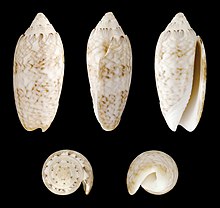Lettered olive
| Lettered olive | |
|---|---|

| |
| Shell of the lettered olive | |
| Scientific classification | |
| Kingdom: | |
| Phylum: | |
| Class: | |
| Order: | |
| (unranked): | |
| Superfamily: | |
| Family: | |
| Subfamily: | |
| Genus: | |
| Species: | O. sayana
|
| Binomial name | |
| Oliva sayana Ravenel, 1834
| |
| Synonyms[1] | |
|
Oliva litterata Lamarck, 1811 | |
The lettered olive, Oliva sayana, is a species of large predatory sea snail, a marine gastropod mollusc in the family Olividae, the olive shells, olive snails, or olives.
Subspecies
Oliva sayana contains the following subspecies:[2]
- Oliva sayana sarasotensis Petuch & Sargent, 1986
- Oliva sayana sayana Ravenel, 1834
- Oliva sayana texana Petuch & Sargent, 1986
Distribution
The species' range is from North Carolina to Florida, the Gulf states of North America, including Louisiana and Texas; and further south to the east coast of Mexico, including Campeche State, Yucatán State and Quintana Roo.[1] It may also occur in Brazil.[citation needed]
Habitat
The lettered olive typically lives in near-shore waters, on shallow sand flats near inlets. The empty shell is occasionally, or sometimes commonly, washed up onto ocean beaches.[citation needed]



Shell description
The shell of this species can be about 6 cm (2+1⁄4 in) long (maximum reported size reaches 9.1 cm[1]). It is a smooth, shiny, cylindrical-shaped shell with a short spire. The aperture is narrow and extending almost the length of shell, continuing around the bottom and ending in a notch on the other side. The suture is V-cut and deep. The lower part of the whorl is just above where the suture extends outward and then at a sharp shoulder drops into the suture.
The shell coloration can vary from cream to a greyish exterior with reddish-brown zigzag markings. The common name of this species is derived from the darker surface markings that sometimes resemble letters.
Life habits
This olive, like all olives, is a carnivore: it captures bivalves and small crustaceans with its foot and takes them below the sand surface to digest.[citation needed]
Its presence is sometimes detected at very low tides by the trails it leaves when it crawls below the surface on semi-exposed sand flats.[citation needed]
Females lay floating, round egg capsules that are often found in beach drift. Young are free swimming.[citation needed]
Human use
Colonists and early Native Americans made jewelry from these shells.[citation needed]
The lettered olive is the state shell of South Carolina.
References
- ^ a b c Malacolog 4.1.1: Western Atlantic Mollusk Species Database. Retrieved April 2010.
- ^ Oliva sayana Ravenel, 1834. Retrieved through: World Register of Marine Species on 26 April 2010.
